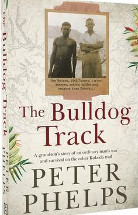The Bulldog Track by Peter Phelps

Hachette, 2018. ISBN 9780733639777
(Age: 14+) Recommended. When the Japanese Army invaded New Guinea in
1942, Australian civilians working as gold miners in the Highland
region of Bulolo fled on foot after the company's aircraft were
strafed and destroyed. Not to be confused with the more legendary
Kokoda track to the East, the Bulldog offered their only means of
escape. However its terrain was more extreme and weather more
appalling than even the almost insufferable conditions endured by
the Australian and Japanese soldiers as they later fought each other
and the landscape.
Peter Phelps' Grandfather Tom was one of the miners who survived.
The author conveys evident and justifiable pride telling this
remarkable story, not just for the man's superhuman effort to endure
the ordeal but equally for his mettle and decency as a human being
throughout his life. Considered unfit for military service due to
age and a massive leg injury, Tom Phelps made the difficult decision
to take work as a carpenter and miner in New Guinea to provide for
his family after financial hardship caused by the Great Depression.
Peter Phelps presents the perspective of his father George, his
sisters and their mother as they are tormented by the absence of
their father and husband for years on end. Whilst Tom missed his
family dearly, living in extreme isolation, complex and lasting
suffering was felt at home, including resentment felt by George.
The family had no knowledge of Tom's welfare or progress beyond the
fact that miners deemed too sick or old to join the New Guinea
Volunteer Rifles had abandoned Bulolo to make their way to New
Guinea's Southern coast. They were however only too aware of the
extreme brutality of the invaders and naturally feared the worst
whilst waiting for any scraps of information.
The trekkers were unsupplied and faced gruelling hardship including
starvation and countless medical problems caused by disease and
mishap. These men would not have survived without the guidance and
physical aid of local New Guinea villagers who had formerly been
employed by the mine but who assumed responsibility for ensuring the
welfare of the escaping miners of Australian and sundry nationality.
It must be emphasised that their own villages and families faced
great danger from the advancing Japanese. Una Beel was a local
highlander assigned as assistant to Tom Phelps in his role as
carpenter and the two developed a close relationship which must have
been pivotal to Tom's survival. I found the description of the
pair's parting after they had been delivered to European
missionaries on the coast to be curiously understated. These
villagers risked their lives sharing the arduous journey and as the
author notes, they were essentially in foreign lands themselves,
having left their own territory. The journey demanded that they
communicate with fearsome, potentially lethal villagers along the
way and it is difficult to imagine the miners' survival without
their efforts.
The author has undertaken tremendously detailed research to give
voice and description to both the plight of his grandfather and the
daily trials of his family waiting at home. The amazing feat of his
indomitable grandfather and his ragged but resilient companions has
been presented in an exciting story demonstrating great family pride
and affection. There is no doubt that Tom Phelps earned this respect
but I was disappointed that Una Beel and his companions were not
acknowledged in the conclusion and epilogue.
Recommended for 14 years +
Rob Welsh